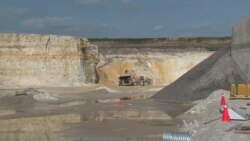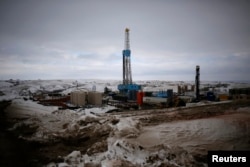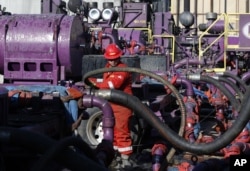Just under the surface of land situated along the Illinois River Valley in the Midwest state of Illinois is a widely used, naturally occurring mineral, which has brought a flurry of interest in property near the home of Utica resident Mary Whipple.
"Silica sand right now is the new white gold," Whipple said.
And more common than one might think.
"Silica sand is in so many things that are used in everyday life that people don't think about," said Nick Fetig, plant manager for Unimin Corporation's silica sand processing facility in Utica. "It's used in coatings and paints and ceramics and things that we touch and handle every day."
Fetig says the fine, white silica sand found beneath the banks of the Illinois River is also ideal for use in the hydraulic fracturing, or "fracking," oil industry.
During the hydraulic fracturing process, which collects oil from shale formations deep below the surface, silica sand is injected into the fractures created in the those formations. The tiny beads of silica sand help keep the fractures open to allow release of the oil.
Growing demand
It is the most reliable material available for this function, which created red-hot demand for silica sand when the fracking business was booming.
"It's been a hot commodity, and we have the best darn sand in the world," said Price Futures Group Senior Market Analyst Phil Flynn. "Saudi Arabia comes to us for the sand. You would think they would have their own sand. But they like our sand better so it's a very, very high-quality sand for what the industry needs."
That need drove up demand, and with it came new silica sand mines in Utica.
"It was like a frenzy. All of a sudden everyone needed silica sand to boost their fracking industry," said farmer Monty Whipple, Mary's husband.
The Whipples live near several new silica sand mines, which are not owned by Unimin — a company that has operated in Utica for several decades.
The Whipples are upset that once-prime farmland has become full of sprawling, open holes in the ground.
"For those of us who have lived in the area our whole life, we want to maintain what we had," Monty Whipple said. "You can't take away that type of natural beauty easily to me."
Falling prices
But the need for silica sand — and with it, new mines — is directly tied to the price of oil, which has plunged in recent weeks. Many parts of the U.S. are now paying 60 cents a liter for fuel.
"The price of oil became too cheap," Mary Whipple explained. "You need a good, strong price per barrel of oil to bring up U.S. shale oil. It's not like the wells in Saudi Arabia."
Phil Flynn agrees.
"Low prices are good for the consumer but not so good for the U.S. producers," he said.
The low cost of fuel makes the high cost of extracting oil by the fracking method financially unfeasible, which has dramatically reduced the amount of new fracking wells being drilled.
"A lot of the banks that lend money to the frackers are a little bit tighter with their wallet right now because they are concerned about the long-term viability of this industry," Flynn said.
Ripple effect
That concern has a ripple effect through many industries, including silica sand. Several mines in the U.S. have already closed or suspended operations because of decreased demand.
"They're producing more oil with less rigs," Flynn said, "but if you stop drilling for rigs, or stop drilling in the shale, or slow that process down, you're not going to have as much demand for the sand."
The nation's largest silica sand provider — U.S. Silica — projects a 15 percent drop in demand.
Its competitor, Unimin, stopped construction on a planned expansion at its Utica facility last year. But plant manager Nick Fetig says there is still demand for silica sand outside the fracking business.
"Unimin is set up to handle the ebbs and flow of the markets," Fetig said.
Unimin's operation in Utica employs about 100 workers.
The company says there have been no permanent reductions in its workforce there as a result of the industry downturn, but there is no date on when the planned expansion of its facility will resume.
Analyst Flynn sees the downturn as a temporary drop.
"The demand for oil is not going away," he said. "We are going through a leveling of the playing field. I think fracking is here to stay, but for the next year or two, it might be rough going."
"From a purely selfish point of view, the lower the oil price, the less fracking interest will be," said Monty Whipple, who adds that while he and his wife are hopeful slowing demand for silica sand will curb the loss of nearby farmland to silica sand mining, they are concerned about what will be left if the current mines shut down permanently.
"Every sand mine that is left in its wake is just an empty hole that collects water from rainfall and so on and turns a nasty color," he said, adding that the one thing the land most likely won't return to, at least in the foreseeable future, is the prime farmland he grew up with.













